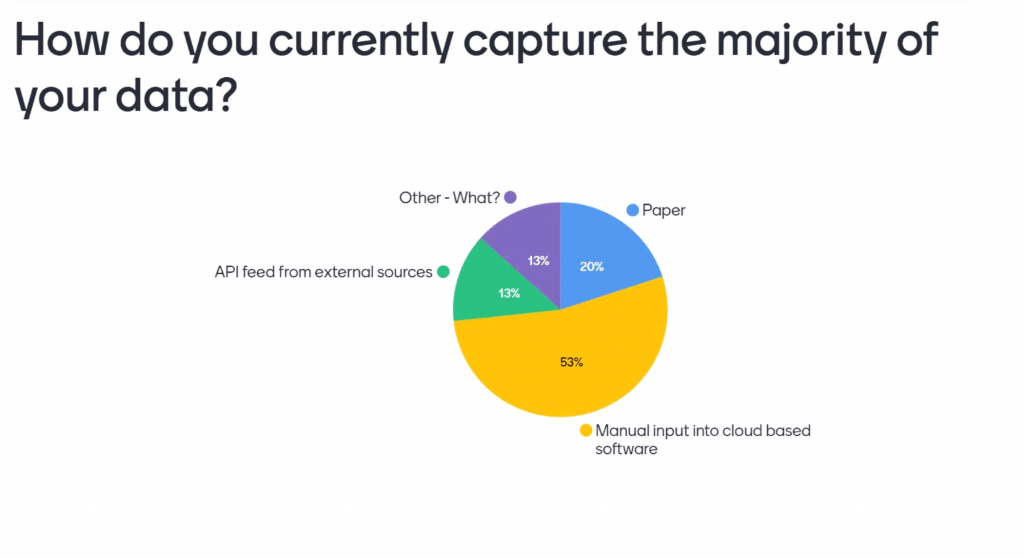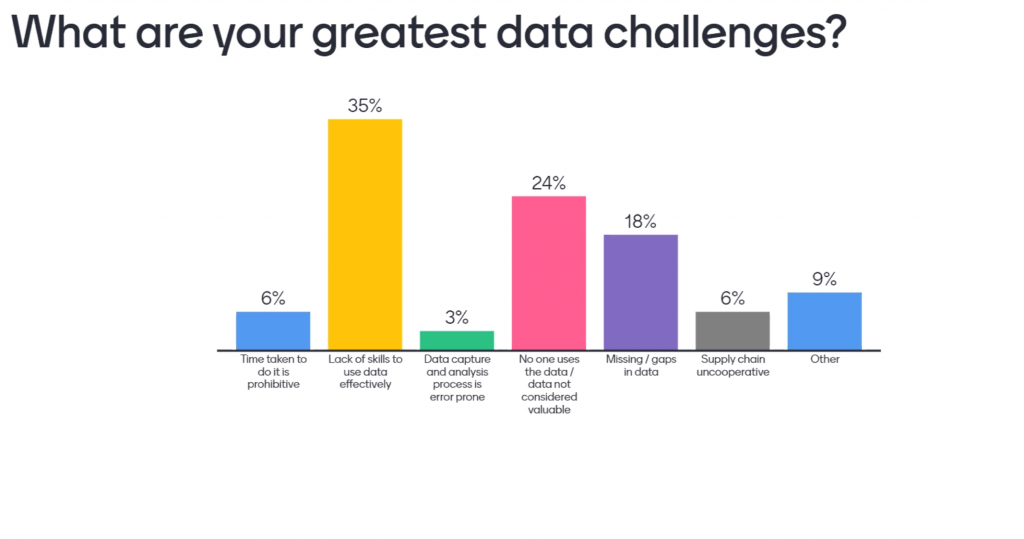Survey results and insights
Achieving net zero in construction has become a matter of urgency. The industry is not adapting fast enough in response to climate change and as one of the highest contributors to carbon emissions, we as an industry need to take full responsibility. According to NASA, even if the world went 100% carbon free today, it could take the Earth centuries to respond. That’s why it is critical that we start making progress quickly.
To progress, we must reduce our current level of emissions. Establishing this current level is a challenge in itself, and identifying the 80:20 opportunity (80% of the gains take 20% of the effort, the remaining 20% of gains take 80 % of the effort) to move from this base line is a separate challenge. Fortunately both these challenges can be addressed, in part, by having good quality data and USING IT to inform decision making.
How is the industry capturing data?
During a workshop, we surveyed 30 construction professionals from major firms across the UK to better understand their data strategies. We found that 20% of them still rely on paper to capture the majority of their data. An overwhelming majority, 72%, still rely on manual data entry to capture most of their project data. This presents several problems. Every additional element of human involvement in data capture poses additional risk of human error which can significantly compromise the accuracy of data. Additionally, it requires tremendous amounts of time. Highly trained and skilled engineers and environmental professionals should not be spending their time entering numbers into spreadsheets. That’s an incredible waste of resources.

To begin taking the first few steps towards net-zero construction, you will need significant amounts of data in highly granular form.The most efficient and accurate way of capturing high volume data is at source from an IoT device, or through a digitally automated process such as an API feed from external sources. This removes human involvement, increases accuracy, and makes the right data available at any given time.
What are the biggest challenges the industry faces?
A notable insight from this survey was how seldom the data is actually used. The majority of firms capture data in one way or another, but they never use it. 24% do not find any considerable value in the data or don’t even use it. This only adds to the problem as it requires significant resources to capture data in the first place. Therefore the return on the effort is 0 and perceived value of data will fall even further. Surprisingly, a staggering 39% of the surveyed professionals have taken no action to solve this problem. Although they are aware of it, it doesn’t land on their list of priorities because they don’t believe it will return value.

On the flip side, 33% have tried to deploy a software solution to take advantage of data. However, only 3% used an AI solution. Unfortunately, this reflects poorly on the positive impact that AI enabled software can have on a construction project. These respondents are left with the impression that software won’t solve their challenges as they have already tried it without success. To take full advantage of your data and resources, AI is a vital tool that must be considered. Without this powerful technology, it will be difficult to extract real, actionable insights from project data.
What can you do?
To get a foothold in the battle of reaching net-zero and grab some quick wins there are a few things you can do.
- Determine what you want to achieve and what supporting data you need to get there.
- Figure out what data you have and what you are missing.
- Identify why there is missing information to determine what part of your data capture approach needs attention.
- Use this data to take action.
The final point may be one of the most important ones. Too often, data is captured and stored, sometimes even analysed, but to no end. If you don’t use the insights gained from your data, they are useless.
Why Big Data and Artificial Intelligence?
We all know that Artificial Intelligence is the hottest buzzword in tech right now. Every company throws this term around generously as if it’s fundamental to building credibility with customers. This buzzword is so overused that it is starting to lose its meaning. We would like to restore the meaning to Artificial Intelligence and give you an idea of why we think it is so important for the construction industry.
Artificial Intelligence is the worlds best assistant. This technology can filter through mountains of data in minutes without ever getting tired or distracted and will always do what you tell it to do. The best sides of Artificial Intelligence is that in the long-term, it’s much more accurate than humans, it’s significantly more resource efficient, and it’s always evolving. The more you use it, the better it gets. Another big benefit is that you can rapidly experiment with different sets of project data to get quick insights for your project.
For the first time in history, you can run highly accurate predictions on your project thanks to Artificial Intelligence. By analysing past project data and 3rd party data, an Artificial Neural Network can predict certain outcomes on your project. For example, a Neural Network can predict cost overruns on projects by looking at historical data, project size, contract type, and competence level of managers. Before the project starts, the model can deliver an expected cost overrun along with recommended proactive solutions to prevent these. In a similar fashion, this process can be used to understand projects carbon emissions and make incremental changes to methodically reduce carbon impact.
If you want to learn more about how to use data to reduce your environmental impact and move towards net zero, reach out to our team at Qflow and schedule a discovery call.

